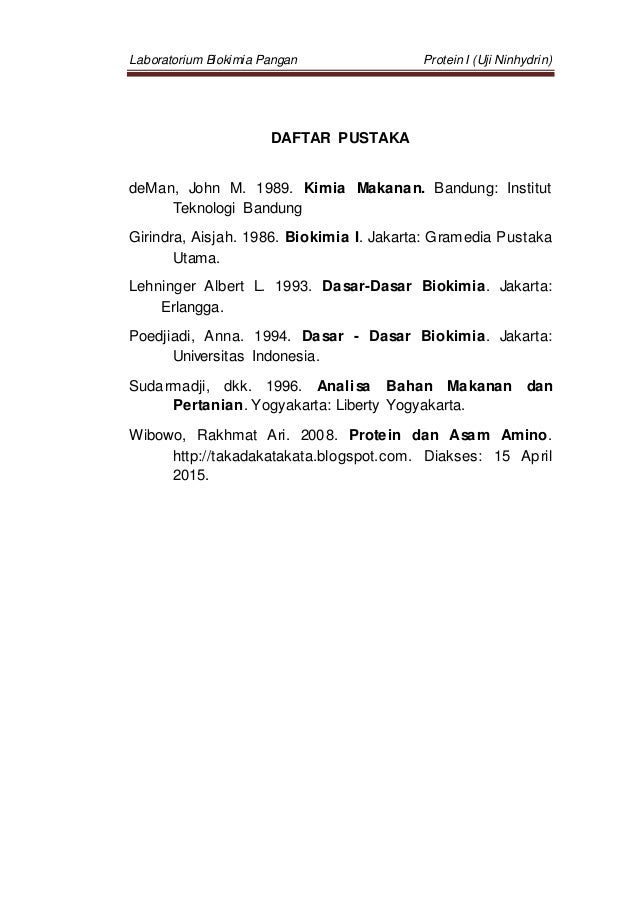Lehninger Dasar-dasar Biokimia Pdf

BIOKIMIA:Pendahuluan Prof. Tata Tertib Kuliah• Tepat waktu, toleransi maks. 15 menit• Tidak Berisik• HP tidak diaktifkan• Hadir minimal 70% boleh ujian• Paham bahasa Indonesia & Inggris• Baca salah satu / dua buku acuan• Pakaian rapi• Kerjakan Tugas, Mid, & Ujian• Ujian bisa lisan 3.
[4] Lehninger 1982 Dasar-Dasar Biokimia Terjemahan (Jakarta: Erlangga). [5] Veeruraj A, Arumugam M and Balasubramanian T 2013 Elsevier Process Biochemistry. [6] Kiruthiga N, Sujithra S and Kumaresan R 2013 International Journal of Institutional Pharmacy and Life Science 3 pp 53-60.
Tujuan Perkuliahan• Mengenalkan dan memahamkan dasar biokimia: Kosakata (istilah dan struktur kimia), tatabahasa (reaksi-reaksi kimia), struktur kalimat (Jalur metabolisme) dan arti (keterkaitan metabolik) 4. Trudy McKee and James McKee.
Biochemistry: The Molecular Basis of Life. Third edition. McGraw- Hill, Boston.2. Lehninger, Nelson, & Cox. Principles of Biochemistry.2nd edition.
Worth Publishers.3. Dasar-dasar Biokimia. (Alih bahasa: Maggy Thenawidjaja). Penerbit Erlangga, Jakarta.4. Dan K-H.Roehm.
Atlas Berwarna dan Teks BIOKIMIA (aliha bahasa: Inawati-Wanandi I, 2001). Penerbit Hipokrates, Jakarta.5. Prinsip-prinsip Biokimia.
Penerbit Unair, Surabaya.6. Biokimia I dan II. Gadjah Mada University Press, Yogyakarta.7.
Biokimia Dasar. Penerbit Rekayasa, Bandung. Dari rumput menjadi daging dan susuFresh grass haySilage 6. Dari pakan konsentrat menjadi daging dan telur 7.
Dari makanan menjadi manusia 8. What is biochemistry?• Definition: – Webster’s dictionary: Bios = Greek, meaning “life” “The chemistry of living organisms; the chemistry of the processes incidental to, and characteristic of, life.” – WebNet dictionary: “Biochemistry is the organic chemistry of compounds and processes occuring in organisms; the effort to understand biology within the context of chemistry.“ 9. What is biochemistry?• Understanding biological forms and functions in chemical terms• Biochemistry aims to understand how the lifeless molecules interact to make the complexity and efficiency of the life phenomena and to explain the diverse forms of life in unifying chemical terms.
Issues addressed by biochemistry• What are the chemical and three-dimensional structure of biomolecules?• How do biomolecules interact with each other?• How does the cell synthesize and degrade biomolecules?• How is energy conserved and used by the cell?• What are the mechanisms for organizing biomolecules and coordinating their activities?• How is genetic information stored, transmitted, and expressed? History of Biochemistry• First to reveal the chemical composition of living organisms. The biologically most abundant elements are only minor constituents of the earth’s crust (which contains 47% O, 28% Si, 7.9% Al, 4.5% Fe, and 3.5% Ca). The six principle elements for life are: C, H, N, O, P, and S.
99% of a cell is made of H, O, N, and C Element # unpaired e’s Fractional amount H 1 2/3 O 2 1/4 N 3 1/70 C 4 1/10 12. Most of the elements in living matter have relatively low atomicnumbers; H, O, N and C are the lightest elements capable of formingone, two, three and four bonds, respectively.
The lightest elements form the strongest bonds in general. History of Biochemistry• Then to identify the types of molecules found in living organisms. • Amino Acids • Nucleotides • Carbohydrates • Lipids 14.
History of Biochemistry• Then to understand how the biomolecules make life to be life. Relationship between Biochemistry and other subjects• Organic chemistry, which describes the properties of biomolecules.• Biophysics, which applies the techniques of physics to study the structures of biomolecules.• Medical research, which increasingly seeks to understand disease states in molecular terms.• Nutrition, which has illuminated metabolism by describing the dietary requirements for maintenance of health.• Physiology: in relation with the all process of maco- and micro molecules in cellular-, tissue or organ levels to give an output 16. Relationship between Biochemistry and other subjects• Microbiology, which has shown that single-celled organisms and viruses are ideally suited for the elucidation of many metabolic pathways and regulatory mechanisms.• Physiology, which investigates life processes at the tissue and organism levels.• Cell biology, which describes the biochemical division of labor within a cell.• Genetics, which describes mechanisms that give a particular cell or organism its biochemical identity.
Life needs 3 things:(1) ENERGY, which it must know how to: • Extract • Transform • Utilize 18. Life needs 3 things:(2) SIMPLE MOLECULES, which it must know how to: • Convert • Polymerize • Degrade 19. (3) CHEMICAL MECHANISMS, to:• Harness energy• Drive sequential chemical reactions• Synthesize & degrade macromolecules• Maintain a dynamic steady state• Self-assemble complex structures• Replicate accurately & efficiently• Maintain biochemical “order” vs outside 20. Trick #1: Life uses chemical coupling to drive otherwise unfavorable reactions 21. Trick #2: Life uses enzymes to speed up otherwise slow reactions 22.
How does an enzyme do it, thermodynamically? How does an enzyme do it, mechanistically?
The Versatile Carbon Atom is the Backbone of Life 25. Chemical Isomers Interconversion requires breaking covalent bonds 26. Download Free Software When Life Nearly Died Pdf Merge.
Stereoisomers: Chemically identicalBiologically different! Stereoisomers:Chemically identicalBiologically different! Biochemical Transformations Fall into Five Main Groups• Group transfer reactions• Oxidation-reduction reactions• Rearrangements (isomerizations)• Cleavage reactions• Condensation reactions 29. Biomolecules – Structure Anabolic• Building block • Macromolecule• Simple sugar • Polysaccharide• Amino acid • Protein (peptide)• Nucleotide • RNA or DNA• Fatty acid • Lipid Catabolic 30. BiosynthesisRequires Simple Molecules to Combine Covalently in Many Ways 31.
Bond strength includes dependence on 1. Relative electronegativities of the two atoms High electronegativity = High affinity for electrons• O 3.5 • P 2.1• Cl 3.0 • H 2.1 • Na 0.9• N 3.0 • K 0.8• C 2.5 32. The number of bonding electrons 33. Common Bond Strengths Approx. Triple: 820 kJ/mole Double: 610 kJ/mole Single: 350 kJ/mole 34. Common Functional Groups 35. Important BiologicalNucleophiles:Electron-rich functional groups 36.
In summary• Tetrahedral carbon has versatile bonding properties• Compounds with many atoms may exist in many isomeric forms• Interconversion requires breaking chemical bonds• Large molecules are built from small ones by making new chemical bonds 37.